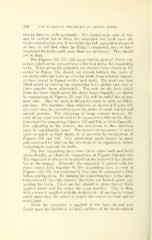Page 550 - My FlipBook
P. 550
260 THE TECHNICAL PROCEDURES IN FILLING TEETH.
caused them to yield gTadually. We should make note of this
and be careful not to force the sejjarator too hard upon the
single-rooted teeth, for, if we attain the full separation required
at once, we will find, when the filling is completed, that we have
separated the teeth much more than was necessary. This should
not be done.
The Figures 333, 334, 335, i-epresent the general Perry sep-
arator, which at the present time is the best device for separating
teeth. When properly adjusted, the slender claws shown in the
center in Figure 333, closed, are placed between the necks of
the teeth while the bows go over the teeth from labial to lingual,
or from buccal to lingual on the back teeth. The teeth are then
lifted apart by turning the separating bars, giving each two or
three quarter turns alternately. The nuts on the bars which
form the bows which move the claws bucco-lingually, as shown
by comparison of Figures 333 and 334, will be called the adjust-
ment nuts. They are used in fitting the claws to teeth of differ-
ent sizes. For instance, when adjusted, as shown in Figure 333,
the claws may be placed between the necks of small central and
lateral incisors. For adjusting to large central incisors, the
ends of the claws would need to be separated a little in the direc-
tion shown by comparing Figures 333 and 334, or labio-lingually.
For adjusting to the molars, the movement in this direction
must be considerably more. The movement necessarj^ is never
t[uite so much as that shown to be possible by comparison of
Figures 333 and 334. This adjustment must always be made
and corrected l)y trial on the two teeth to be separated, before
lieginning to separate the teeth.
The two separating bars move these claws back and forth
mesio-distally, as shown by comparison of Figures 334 and 335.
The separator is always to be placed on the teeth with the shorter
bar to the lingual. Generally the separator is placed with the
claws closed fully together by the separating bars, as seen in
Figures 333, 334, but occasionally they may be separated a little
before putting it on. By turning the separating bars in the direc-
tion shown by the little arrows, the claws are forced apart, sep-
arating the teeth. First one bar should be given two or three
(puirter turns and the other the same number. This is done
with a wrench su])plied with the instrument. Tf one bar is turned
much more than the other, it causes the screws to l)ind and to
work hard.
When the separator is applied, if the bows do not rest
firmly upon the incisal or occlusal surfaces of the teeth without


